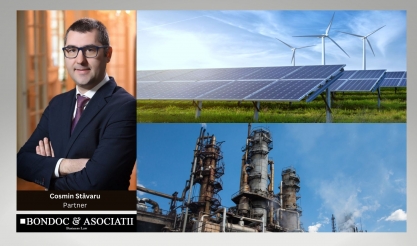
Green Deal and “Drill, Baby, Drill”
04 Februarie 2025 Cosmin Stăvaru - Partener Bondoc & Asociații
In this complicated international political context, the policy makers both at EU level and in Romania will have to carefully navigate the geopolitical storm with the clear vision of a safe harbor. As Seneca said, “if one does not know to which port one is sailing, no wind is favorable”.

|
We do live in interesting times nowadays when the world is changing fast, and Romania is still in a state of an electoral suspense.
1. While the USA may go less green, EU seems to go greener
One of the first executive acts of the new US President was to suspend all new leases on federal land and generally the support for renewable capacities1. “Drill, baby, drill” is the new slogan in the US.
This might make up to a point some good sense for US, given the extent of its gas and oil reserves and the enormous gas and oil generation industry. Thus, on the one hand, US is currently the no. 1 worldwide producer of both oil and natural gas, and no. 4 worldwide in terms of proved reserves of natural gas, and on the other hand no.11 worldwide as regards proved reserves of crude oil2. With such good reserves, the “Drill, baby, drill” policy attempts to solve two problems with one solution – putting to use a natural resource and saving an existing large industrial segment (among the largest in the world). But it is also the weaponization of oil and gas in the global power struggle against Russia and China that presumably plays a role here.
In this geopolitical storm, EU seems to remain consistent with the past years. Thus, the EU Commission has largely reconfirmed its commitment to the green policies, as stated by the President of the Commission, Mrs. von der Leyen3, and as also reflected in the recent EU Commission Communication called “A Competitive Compass for the EU” issued on 29 January 2025 (the “Competitiveness Compass”).
The Competitiveness Compass draws on the conclusions of the Mario Draghi report on the future of European competitiveness from September 20244, meant as a strategic roadmap for future actions enabling EU to boost its competitiveness on the global scene and keep pace with its greatest competitors – US and China. While one of the targets pursued by the Competitive Compass is to simplify bureaucracy and encourage innovation, the Green Deal’s targets/policies do not seem to be questioned and green energy remains a key EU goal as opposed to the “Drill, baby, drill” path that USA is looking to for the following period.
Thus, the Competitiveness Compass states that “Europe has set out an ambitious framework to become a decarbonised economy by 2050. It will stay the course, including through the intermediate 2040 target of 90%”. Also, “the EU must thus accelerate the clean energy transition and promote electrification”. To this end, simplified and accelerated permitting is a tool specifically promoted by the Competitiveness Compass. On the other hand, the Competitiveness Compass adds a Clean Industrial Deal to the Green Deal, which will be “aimed at securing the EU as an attractive location for manufacturing, including for energy intensive industries, and promoting clean tech and new circular business models, in order to meet its agreed decarbonisation objectives”.
In the context above, the changes of policy in the US with respect to green projects (for instance, large offshore wind projects are put on hold) may be to Europe’s advantage as the green energy investors may relocate from US to Europe.
2. Romania’s standing
Certainly, this signal from Brussels is encouraging for the green energy industry, but some critical voices have also been heard at national level in several countries, including Romania, arguing that the higher energy prices in Europe are due to the quick pace of the energy transition set by the Green Deal labeled as a “utopia”.
As far as Romania is concerned, despite such political statements, the Ministry of Energy has been active in promoting and implementing the support schemes for renewables with EU funds (National Recovery and Resilience Plan, Modernization Fund, CfD scheme) which financed green capacities from EU money and with no significant costs for the Romanian consumers. Also, the electricity price hikes in Europe in the past few years seem to have been mostly generated by the gas crisis in the context of the war in Ukraine rather than by the renewable industry, which was seen as a strategic alternative to the dependency of gas imports.
Moreover, the current situation of the Romanian electricity generation system seems to be rather due to some specific problems of the Romanian energy market and not to the Green Deal, including the failure to replace the old and obsolete, no longer functional, conventional capacities with new energy power plants (including green and nuclear).
Practically, between 2016 and 2022, almost no new generation capacities were installed, while some old capacities cease to operate. For instance, in 2020 ANRE carried out a review of the existing operating licenses, as the total installed capacity of Romania “on paper” was over 20.5 GW out of which only 16 GW were believed to be still operational.5 It is only over the past 2 years that new capacities have seen a noticeable (although still slight) progress – 624 MW of new capacities installed in 20236 and 950 MW in 2024 with the expectation for another approx. 2,700 MW by the end of 20257.
Anyway, there have been some legal developments over the past few months that should foster optimism amongst investors in green energy production facilities, including the following:
a) Finalization of the long-awaited strategic documents for the Romanian energy sector (Romania’s new 2025 – 2035 Energy Strategy with a 2050 perspective adopted under Government Decision No. 1491/2024 and the final version of the 2021-2030 Integrated National Energy and Climate Plan sent to the EU Commission in October 2024)
Both strategic documents regulate sustainable targets for renewables’ weight in the total energy consumption: (i) 38.4% in 2030, (ii) 44% in 2035 and (iii) 73% in 2050. Also, there are some indicative targets for specific renewable sectors such as 19.5 GW new solar and wind capacity installed until 2035 or 2 GW capacity of energy storage installed until 2030-2035.
b) Enactment of favorable legislation for energy storage facilities (BESS)
As regards the energy storage, this was declared a “zero priority” by the Minister of Energy8. There are 2 schemes (with a budget of EUR 150 million each) dedicated to co-located and standalone BESS, financed from the Modernization Fund.
However, the most expected change was brought by the removal of “double taxation” of storage facilities (done under Government Emergency Ordinance No. 134/2024). This double taxation stemmed from the fact that, lacking a specific exemption, the storage facilities were seen as producers when they injected the energy in the grid and as consumers when they stored the energy from the grid and, consequently, they had to pay transmission fees in both forms – injection and extraction tariff, as well as the green certificates/cogeneration contribution, as any other consumer.
Also, it has been clarified that the BESS may be developed in the dual use system on pastures, as will be shown below.
c) Adoption of dual use norms for pastures
A big step forward to unlock the potential for green projects was the adoption (with some 2 years delay) of the application norms for dual use applied to pastures, which effectively allows for the development of green energy projects on pastures, removing a critical barrier.
The stake of the dual use concept is the surface of land that needs to be removed from the agricultural circuit – the entire land used in the case of simple projects versus the footprint of the constructions in the case of projects developed in a dual use system. This could make a huge difference in terms of surface for both wind and solar projects. This is important because of the legal requirement to compensate the pastureland removed from the agricultural circuit with an equal surface of unproductive land that must be procured by the investor and turned into pasture. It is not only a matter of costs but also of availability of such unproductive lands in most of the towns and communes in Romania.
While the dual use was introduced in the Romanian legislation under Law 254/2022 amending Law 18/1991 (“Law 254/2022”), no express implementing norms were enacted to detail the principles regulated by the law and, as a result, the Ministry of Agriculture was reluctant to endorse the dual use projects so far. Consequently, the large pastureland surfaces in Romania remained unused for green energy production although the law allows it.
On 23 December 2024, Government Decision 1700/2024 amending Implementing Rules for the application of the provisions of Government Emergency Ordinance no. 34/2013 on the organization, management and exploitation of permanent pastures (“GD 1700/2024”) was issued with the much-awaited details on how the dual use would work in practice. For example, GD 1700/2024 (i) requires that the contracts concluded for dual use must include certain mandatory clauses (e.g., the agricultural area intended for agricultural activities, the grazing capacity and period, management measures for the grazing land, the area occupied by the renewable energy investment objectives etc.) and (ii) defines the surface to be removed from the agricultural circuit as consisting in areas for the structure poles, wind turbine foundations, inverters, transformer stations, electricity storage units, independent protective grounding and lightning protection systems, access roads, fencing, and other constructions/parts necessary for the operation of this facility, as set out in the technical design, but no more than 20% out of the total surface of 50 hectares per investment objective.
GD 1700/2024 also lists the electricity storage capacities (standalone) as also benefiting from the dual use system.
d) Favorable clarification of the legal status of land owned by associative forms of land holding (compossessorates)
Another important step in enlarging the land base for renewables is the clarification brought by the High Court of Cassation and Justice on the legal regime of lands owned by compossessorates, in the sense that a superficies right can be validly created over such lands for the purpose of green energy projects. The practical issue was that according to Law No. 1/2000 on the reinstatement of ownership over agricultural and forest land (“Law 1/2000”) such lands were inalienable, a prohibition that was often construed by courts, the land book offices and notaries public as including a prohibition to create a dismemberment of the ownership right such as a superficies right.
Decision no. 102/2024 of the High Court of Cassation and Justice, which contains a generally binding interpretation of the legal issue raised, asserted that the creation of a superficies right is compatible with the alienation prohibition regulated by Law 1/2000 provided such superficies right does not contravene the forestry or agricultural legal regime and the bylaws of the associative forms (which may, therefore, need to be amended before entering into the relevant superficies contracts).
3. Looking to the future
These recent developments of the legislative framework enable the further progress of renewable projects and add up to the elimination of urban planning documentation for renewable projects (limited to 50 hectares for extra muros land)9.
In this complicated international political context, the policy makers both at EU level and in Romania will have to carefully navigate the geopolitical storm with the clear vision of a safe harbor. As Seneca said, “if one does not know to which port one is sailing, no wind is favorable”.
In this respect, the Competitiveness Compass promises to uphold the Green Deal by aligning it to the welfare objectives of both the European consumer and the European industry. Romania has a lot to win out of this approach as well and should avoid the mistakes of the past given that shifting policies have had a destabilizing effect. Not any destruction is a creative destruction.
2. See, for example https://www.worldatlas.com/industries/the-world-s-largest-oil-reserves-by-country.html and https://worldpopulationreview.com/country-rankings/natural-gas-by-country.
9. However, it should not be forgotten that Law 254/2022, which introduced this exemption for extra muros land, provides that it applies until the end of 2026, so that only projects developed in the next 2 years will continue to benefit from this exemption.
| Publicitate pe BizLawyer? |
  |
| Articol 55 / 4478 | Următorul articol |
| Publicitate pe BizLawyer? |
 |

Promovări în echipa Filip & Company: Andreea Bănică și Alin Grapă ajung pe poziția de Counsel, alți patru avocați urcă în ierarhie | Cristina Filip, co-managing partner: ”Prin aceste promovari consolidăm fundamentele organizației printr-o noua generație de avocați excepționali”
Răsturnare de situație: doar trei case locale de avocați rămân în topul global al celor mai bune 100 de firme implicate în arbitraje internaționale | Filip & Company intră în top, iar două firme cu un trecut bogat în domeniul arbitrajelor și prezență constantă în ghidurile de profil au părăsit clasamentul. ZRVP și LDDP rămân pilonii prezenței românești în GAR 100, ediția 2025
“ICC Arbitration Breakfast in Romania” – eveniment privind arbitrajul ICC, 14 mai 2025, București
LegiTeam: Atorney at Law | Dispute Resolution for commercial ̸ administrative litigation and arbitration | Reff & Associates
NNDKP a asistat MedLife cu privire la majorarea limitei unui credit sindicalizat cu 50 milioane EUR. Ce avocați au fost în echipa de proiect
Schoenherr a asistat Verbund cu privire la achiziția unui proiect eolian de 272 MW de la Monsson. Echipa a fost coordonată de Monica Cojocaru (partner)
BACIU PARTNERS câștigă premiul ‘Firma de Copyright & Design a Anului în România’ la gala Managing IP EMEA Awards 2025, desfășurată la Londra. Andreea Bende (Partener), premiată ca ‘Practicianul Anului în România’ | Ana-Maria Baciu, Managing Partner: ”Este o reconfirmare a faptului că principiile pe care le integrăm în fiecare proiect creează în mod constant valoare tangibilă, vizibilă și demnă de recunoaștere”
CMS România își mărește echipa în România prin cooptarea strategică a unui senior counsel și lansează practica de Apărare | Horea Popescu (Managing Partner): „Cristian Băcanu se remarcă printr-o combinație unică de experiență juridică, leadership în sectorul public și viziune internațională, ceea ce îl recomandă ca un membru valoros al echipei noastre”
LegiTeam: POPESCU & ASOCIAȚII recrutează avocați stagiari (București)
Cei mai buni litigatori din România, văzuți de Chambers Europe 2025 | Cine sunt practicienii apreciați de clienți în practica de Dispute Resolution și ce spun clienții despre aceștia. Nouă avocați români sunt evidențiați în practica de arbitraj
LegiTeam: Zamfirescu Racoţi Vasile & Partners recrutează avocat definitiv dreptul muncii | Consultanță
Trei avocați români de la Bondoc & Asociații, Filip & Company și DLA Piper sunt considerați ‘Eminent Practitioners’ în practica de fuziuni și achiziții. Clasamentul Chambers Europe 2025, cu cei mai buni avocați de Corporate ̸ M&A din România
-
BizBanker
-
BizLeader
- in curand...
-
SeeNews
in curand...











 RSS
RSS














































